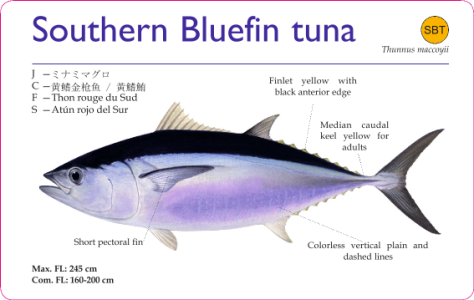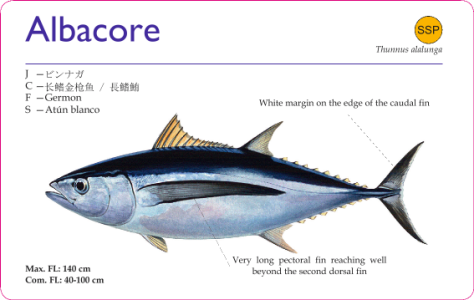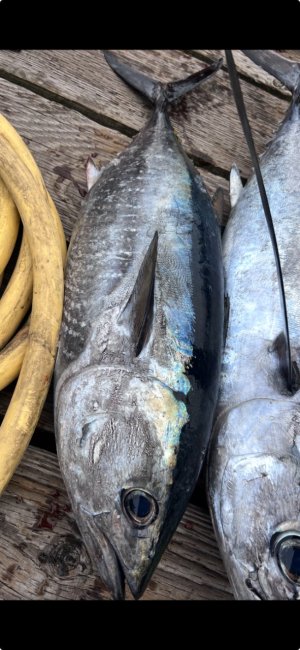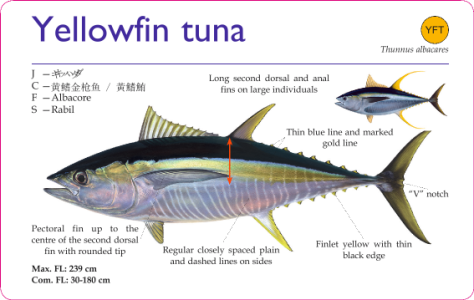You are using an out of date browser. It may not display this or other websites correctly.
You should upgrade or use an alternative browser.
You should upgrade or use an alternative browser.
Can you identify this tuna?
- Thread starter Rain City
- Start date
Dogbreath
Well-Known Member

Bigeye tuna - Wikipedia
Rain City
Crew Member
Not mine but a friend's and out of BC.Looks more juvenile bluefin to me, not a good photo to ID properly though. Crazy amount of 10 to 30lb BFT down southern Cali right now.
Charter Tofino
Well-Known Member
Juvenile BFT. Lots in local waters this season.
Rain City
Crew Member
There's a confident answer.Juvenile BFT. Lots in local waters this season.
Key to Tunas and Mackerels
1.a. Dorsal fins are widely separated. Short pectoral fin. Wavy black bars on dorsal surface - Pacific Mackerel (Scomber japonicus) (64 cm / 25 in) - common species
1.b. Dorsal fins not widely separated - go to 2
2.a. Pectoral fins long (extend past the end of the first dorsal fin) - go to 3
2.b. Pectoral fins short (do not extend to the end of the first dorsal fin) - go to 5
3.a. Pectoral fins very long (extend past second dorsal fin) and are dark in color - Albacore (Thunnus alalunga) (137 cm / 54 in) - primary species
3.b. Pectoral fins do not extend past second dorsal fin and are yellow in color - go to 4
4.a. Second dorsal and anal fins elongate in adults. No striations (lines) on underside of liver - Yellowfin Tuna (Thunnus albacares) (1.9 m / 6.5 ft) - rare species
4.b. Second dorsal and anal are not elongate. Striations (lines) on underside of liver - Bigeye Tuna (Thunnus obesus) (2.4 m / 8 ft) - rare species
5.a. No dark stripes on body. White dots in lines on belly and up sides - Bluefin Tuna (Thunnus thynnus) (1.9 m / 6 ft) - rare species
5.b. Dark stripes along body. No white dots in lines - go to 6
6.a. Four to five horizontal black stripes along sides and belly - Skipjack Tuna (Euthynnus pelamis) (102 cm / 40 in) - rare species
6.b. Angled black stripes extending from mid-body onto back - Pacific Bonito (Sarda chiliensis) (102 cm / 40 in) - rare species


1.a. Dorsal fins are widely separated. Short pectoral fin. Wavy black bars on dorsal surface - Pacific Mackerel (Scomber japonicus) (64 cm / 25 in) - common species
1.b. Dorsal fins not widely separated - go to 2
2.a. Pectoral fins long (extend past the end of the first dorsal fin) - go to 3
2.b. Pectoral fins short (do not extend to the end of the first dorsal fin) - go to 5
3.a. Pectoral fins very long (extend past second dorsal fin) and are dark in color - Albacore (Thunnus alalunga) (137 cm / 54 in) - primary species
3.b. Pectoral fins do not extend past second dorsal fin and are yellow in color - go to 4
4.a. Second dorsal and anal fins elongate in adults. No striations (lines) on underside of liver - Yellowfin Tuna (Thunnus albacares) (1.9 m / 6.5 ft) - rare species
4.b. Second dorsal and anal are not elongate. Striations (lines) on underside of liver - Bigeye Tuna (Thunnus obesus) (2.4 m / 8 ft) - rare species
5.a. No dark stripes on body. White dots in lines on belly and up sides - Bluefin Tuna (Thunnus thynnus) (1.9 m / 6 ft) - rare species
5.b. Dark stripes along body. No white dots in lines - go to 6
6.a. Four to five horizontal black stripes along sides and belly - Skipjack Tuna (Euthynnus pelamis) (102 cm / 40 in) - rare species
6.b. Angled black stripes extending from mid-body onto back - Pacific Bonito (Sarda chiliensis) (102 cm / 40 in) - rare species


Attachments
Old Blue
Well-Known Member
Those little guys aren't as tasty as slightly larger models in the 50lb+ range, less fat content/flavour. Not really any belly cut or any chance of collars to grill up (kama)Please send loin to my address for further evaluation.
Similar threads
- Replies
- 0
- Views
- 241


